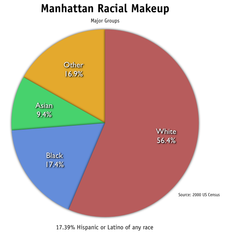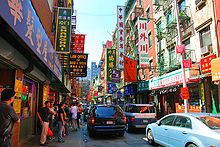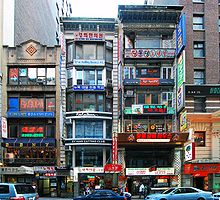- Demographics of Manhattan
-
Population trend[1] Year Inhabitants 1698 4,937 1703 4,375 1712 5,840 1723 7,248 1731 8,622 1737 10,664 1746 11,717 1749 13,294 1756 13,046 1771 21,863 1790 33,131 1800 60,489 1810 96,373 1820 123,706 1830 202,589 1840 312,710 Year Inhabitants 1850 515,547 1860 813,669 1870 942,292 1880 1,164,673 1890 1,441,216 1900 1,850,093 1910 2,331,542 1920 2,284,103 1930 1,867,312 1940 1,889,924 1950 1,960,101 1960 1,698,281 1970 1,539,233 1980 1,428,285 1990 1,487,536 2000 1,537,195 2010 1,585,873 New York County, also known as Manhattan, is the most densely populated state county in the United States, with a density of 70,595.3/mi2 (27,267.4/km2) as of 2007. In 1910, it reached a peak of 101,548/mi2 (39,222.9/km2).
At the 2010 Census, there were 1,585,873 people living in Manhattan, an increase of 3.2% since 2000.
Contents
Demographics from the 2010 census
According to the 2010 Census, 48.0% of the population was non-Hispanic White, 12.9% non-Hispanic Black or African American, 0.1% non-Hispanic American Indian and Alaska Native, 11.2% non-Hispanic Asian, 0.3% from some other race (non-Hispanic) and 1.9% of two or more races (non-Hispanic). 25.4% of Manhattan's population was of Hispanic, Latino, or Spanish origin (they may be of any race).
Manhattan has the second highest percentage of non-Hispanic Whites (48%) of New York City's boroughs , after Staten Island (where non-Hispanic Whites make 64.0% of the residents).
Demographics from the 2000 census
The 2000 census, there were 1,537,195 people, 738,644 households, and 302,105 families residing in the county. The population density was 25,859.8/km2 (66,951/mi2). There were 798,144 housing units at an average density of 13,421.8/km2 (34,756.7/mi2). The racial makeup of the county was 54.36% White(45.79% White Non-Hispanic), 9.40% Asian, 0.07% Pacific Islander, 17.39% African American, 0.50%Native American, 14.14% from other races, and 4.14% from two or more races. 27.18% of the population were Hispanic of any race. 29.43% of the population was foreign born; of this, 48.4% came from Latin America, 27.1% from Asia, 18.4% from Europe and 6.1% from other parts of the world.[2]
In the census of 2000, the neighborhoods in Lower Manhattan (i.e., Manhattan south of Houston street) has a sharply different population than the rest of the borough with 41% Asian, 32% white (non-Hispanic), 19% Hispanic, and 6% black. In addition, 43% of the inhabitants were immigrants. The high number of immigrants are related to those in Chinatown, whose population accounts for 55% of the total of Lower Manhattan.[citation needed]
2009 American community survey
According to the 2009 American Community Survey, White Americans made up 58.9% of Manhattan's population; non-Hispanic whites made up 50.7% of the population. Black Americans made up 15.5% of Manhattan's population; non-Hispanic blacks made up 13.0% of the population. Native Americans made up 0.3% of the population. Asian Americans made up 10.3% of the population. Multiracial Americans made up 3.4% of the population. Hispanics and Latinos made up 23.8% of Manhattan's population.[3]
White Americans are the largest racial group in Manhattan; whites make up 58.9% of the borough's population. Whites of non-Hispanic origin form a slight majority, making up 50.7% of the population. Of Manhattan's 1,630,000 people, 960,000 are white, of which 825,000 are non-Hispanic whites. Manhattan's white population is ethnically heterogeneous. Irish Americans and Italian Americans are the largest Euro-American ethnic groups in the borough, making up 6.9% and 5.5% of the population respectively. German Americans and Russian Americans are also sizable groups; people of German descent make up 7.2% of the population, while those of Russian heritage represent 6.2% of the populace. Americans of English descent form 5.2% of the borough's population, and Polish Americans make up 4.8% of the populace. Americans of French descent make up 1.9% of Manhattan's population, while those of Scottish descent form 1.3% of the populace.
Black Americans make up 15.5% of the borough's population and are concentrated primarily in the Upper Manhattan region of Harlem. The percentage of Blacks in Manhattan has continually been on the decline since the end of World War II.[citation needed] This is in large part due to the exodus of Black residents from Harlem which peaked in population in 1950[citation needed] and the establishment of Black communities in the other boroughs such as Bedford Stuyvesant, Brooklyn, Southeast Queens, and the Northeast Bronx. Blacks of non-Hispanic origin form 13.0% of the population. Roughly 253,000 are black, of which 211,000 are non-Hispanic blacks. Roughly 27,000 residents reported their ancestry as Sub-Saharan African in the survey, which is equal to 1.6% of Manhattan's population.
Native Americans are one of the borough's smallest ethnic minority groups. Only 5,500 individuals of the borough's 1.6 million people are Native Americans. The number of Native Americans who are of non-Hispanic origin is even smaller. Roughly 1,370 residents are Native Americans of non-Hispanic descent, which is 0.1% of the population. In addition, people who are of mixed Caucasian and Native American ancestry make up 0.2% of the population.
Asian Americans are one of the borough's larger racial groups. Asians represent 10.3% of Manhattan's population. Asians of non-Hispanic origin make up 10.2% of the population. Like the Caucasian population, the Asian population is ethnically heterogeneous. Chinese Americans make up the majority of the Asian population. Of Manhattan's 168,000 Asians, some 90,000 are of Chinese descent (5.6% of the population). Roughly 21,000 residents are of Indian descent. Manhattan is home to over 16,300 Koreans, 15,200 Japanese, 11,800 Filipinos, and nearly 3,000 Vietnamese.
32nd street in Manhattan's Koreatown, 2009.
Pacific Islander Americans are, by far, the smallest racial minority group in Manhattan. Just over 540 people identified themselves as such. Also, just above 270 individuals are Pacific Islanders of non-Hispanic origin.
Multiracial Americans are a smaller minority group in Manhattan, but they are sizable. Nearly 55,000 multiracial individuals call Manhattan home, and they make up 3.4% of the population. People of European American and African American heritage form 1.4% of the population, and number over 22,200 individuals. In addition, people of Caucasian and Asian heritage make up 0.8% of the population, and number over 13,400 individuals. People of African American and Native American heritage make up 0.1% of the population, and they number at nearly 1,800 individuals.
Hispanic and Latino Americans are the largest ethnic minority group in Manhattan. Over 387,000 Hispanics and Latinos represent 23.8% of Manhattan's total population. Significant groups include Puerto Ricans, Dominicans and Mexicans; Puerto Ricans make up 6.7% of the population, and number over 109,000 individuals. Mexicans make up 2.7% of the population, and number over 43,000 individuals. In addition, the borough is home to over 10,000 Cubans; people of Cuban descent form 0.6% of the population. Lastly, there are over 224,000 Hispanics that are of other ethnic groups, such as Ecuadorian, Salvadoran, etc. These people collectively make up 13.8% of the population. Hispanics are numerous throughout the borough but most prominently in East Harlem, Loisada, and Washington Heights.
Household income
There were 738,644 households out of which 17.1% had children under the age of 18 living with them, 25.2% were married couples living together, 12.6% had a female householder with no husband present, and 59.1% were non-families. 48.0% of all households were made up of individuals and 10.9% had someone living alone who was 65 years of age or older. The average household size was 2.00 and the average family size was 2.99.
In the county the population was spread out with 16.8% under the age of 18, 10.2% from 18 to 24, 38.3% from 25 to 44, 22.6% from 45 to 64, and 12.2% who were 65 years of age or older. The median age was 36 years. For every 100 females there were 90.3 males. For every 100 females age 18 and over, there were 87.9 males. The largest age cohort in the county was 25–29(recent college graduates).[5]
The median income for a household in the county was $47,030, and the median income for a family was $50,229. Males had a median income of $51,856 versus $45,712 for females. The per capita income for the county was $42,922. About 17.6% of families and 20.0% of the population were below the poverty line, including 31.8% of those under age 18 and 18.9% of those age 65 or over.
Manhattan is one of the highest-income places in the United States with a population over 1,000,000. In particular the Upper East Side, ZIP Code 10021, with over 100,000 inhabitants and a per capita income of over $90,000, is one of the largest concentrations of extreme wealth in the entire United States. Nevertheless, like all large US cities, Manhattan does have some large enclaves of concentrated poverty.[citation needed]
Religion
New York County is diverse religiously and ethnically. According to a report by The Association of Religion Data,[6] the largest religious affiliation in Manhattan is the Roman Catholic Church, whose adherents constitute 564,505 persons (more than 36% of the population) and maintain 110 congregations. Jewish-Americans comprise the second largest religious group, with 314,500 persons (around 20.5%), and have 102 congregations. Other large denominations include Protestants (139,732 adherents) and Muslims (37,078).
Jewish Americans, most of whom self-identify as "white" under the U.S. Census classifications, are most concentrated in the Upper West Side, Upper East Side, and Midtown regions of Manhattan.
See also
References
- ^ Greene and Harrington (1932). American Population Before the Federal Census of 1790. New York., as cited in: Rosenwaike, Ira (1972). Population History of New York City. Syracuse, N.Y.: Syracuse University Press. p. 12. ISBN 0815621558. (for 1698–1771 only)
- ^ Census 2000 Demographic Profile: New York County. Factfinder.census.gov. Retrieved on 2011-06-12.
- ^ a b New York County, New York – ACS Demographic and Housing Estimates: 2009. Factfinder.census.gov. Retrieved on 2011-06-12.
- ^ New York County, New York – Selected Social Characteristics in the United States: 2009. Factfinder.census.gov. Retrieved on 2011-06-12.
- ^ Population Pyramid and Age Distribution Statistics. CensusScope. Retrieved on 2011-06-12.
- ^ The Association of Religion Data Archives | Maps & Reports. Thearda.com. Retrieved on 2011-06-12.
New York City The Five Boroughs: Brooklyn · Manhattan · The Bronx · Queens · Staten Island History · Neighborhoods · Architecture · Skyscrapers · Tourism · Attractions · Culture · Books · Arts · Parks · Cuisine · Dialect · People · Music · Sports · Media · Economy · Companies · Education · Schools · Government · Mayor · Central Park · Council · Fire · Police · Landmarks · Crime · Elections · Geography · Harbor · Gardens · Flag · Environment · Demographics · Enclaves · Transportation · Hospitals · Lists · Images · Portal
New York metropolitan area · New York State · United States Categories:
Wikimedia Foundation. 2010.



